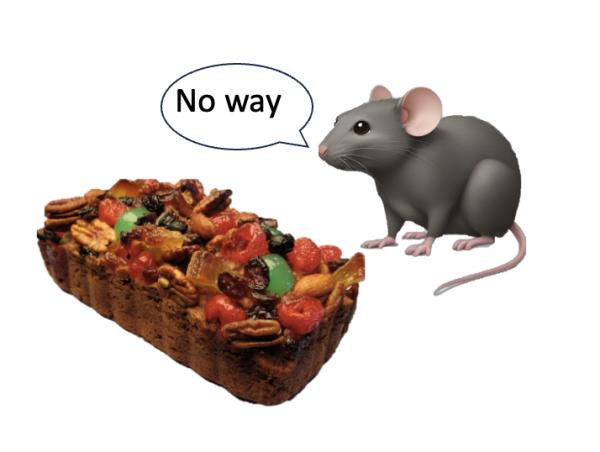Christmas is around the corner, and that means a bunch of bad gifts are heading your way. Some will be merely bad, like a calendar with a different cat hairball for every month. But even though you'd be hard-pressed to find anyone who actually wants a wall calendar, let alone one with hairballs, at least has the year on it, so it is unlikely that it was regifted. No, some misguided soul at least spent the time and money to purchase it. Some other gifts are obviously regifted. Go ahead and try to convince me that you didn't regift a Chia Head back whenever those monstrosities first came out.
Can't get a much worse gift than this, right?
Wrong, it can. At least when you throw the Chia Head out the window, it makes a satisfying sound when it hits the pavement. And if it lands on someone, it probably won't kill them. The same cannot be said for the truly hideous fruitcake, perhaps the most regifted gift of all.
Since ACSH believes in evidence-based science, one of my research projects for next year is to rigorously test my proposed theory that only a few dozen fruitcakes have ever been made on Earth and that they all circulate in random patterns during holiday time, resting for 12 months, only to be unleashed on the world a year later.
(I'm aware of this because of a little-known fact: Bill Gates did not begin tracking vaccine victims with microchips. His pilot program started tracking fruitcakes. I mean real fruitcakes, not the vaccine conspiracy variety, just to show that the technology was reliable.)
Let's leave that alone for a while and focus on the issue at hand: using chemistry to show how old these things are. This means it's time for:

Steve (left) and Irving, your eternal hosts of TDCLFH® never get into the holiday spirit because it's a constant 5,000 oF down there. But they are trying – in their own way – to be congenial. Here, they host a special holiday chemistry lesson.
How to tell how old things are
All elements have one or more isotopes, usually caused by extra neutron(s) in the nucleus. Some isotopes are stable, for example, 2H (deuterium) and 13C, and some are unstable, like 14C or all uranium isotopes. Unstable isotopes decay at specific rates, emitting a nuclear particle plus energy in the process. Measuring the ratio of 12C to 14C in a sample can tell you its age. Here's how (Figure 1).
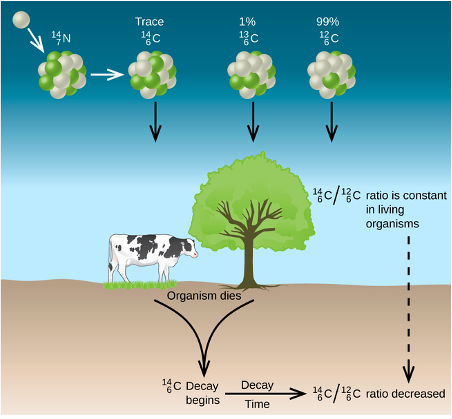
Figure 1. Diagram: Wikimedia Commons
A trace amount of 14C is formed in the atmosphere when nitrogen (14N) reacts with sunlight. Once formed, it immediately begins to decay back to 14N with a half-life of 5,730 years. The 14C, in the form of 14CO2, is taken up by plants, just like normal carbon dioxide. As the 14CO2 (or whatever the plant has converted it to) decays, it is replenished by more atmospheric 14CO2. So the plant will always contain the same level of 14C as long as it remains alive. Likewise, as animals eat the plants, they will be taking in 14C at the same rate as it decays. This means that the ratio of 14C to 12C is the same in all living organisms.
But once an organism dies, it will no longer take up 14C, and whatever radioactive carbon it contains begins to steadily decay. Then, the ratio of 14C to 12C in non-living material acts like an "atomic clock." The less 14C, the older the specimen. This ratio can be measured by a technique called mass spectrometry.

Image: Wikimedia Commons
Example: If a wood artifact has half the amount of 14C found in a living tree, then that wood is 5,730 years (one half-life) old. If it has only 25%, the artifact must be 11,460 years old. After nine half-lives (51,000 years), only 0.0015% of the 14C remains, and it gets hard to measure; 14C is no longer helpful in dating specimens older than about 50,000 years.
How Old is This Fruitcake?
In determining how many times a fruitcake has been regifted, its age may provide vital clues. Is the thing someone dumped on you five years old? 20? Let's do some math on fruitcake #17.
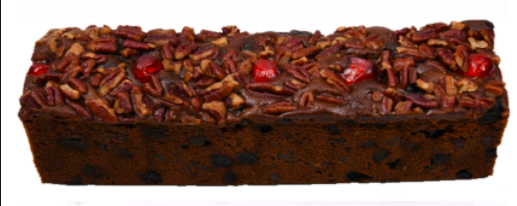
Fruitcake #17. Photo: Walmart
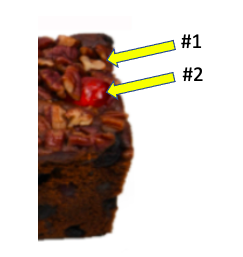
First, we tested that ear wax-looking thing marked #1. The mass spec indicated that 99.4% of the 14 C remained. If you plug that number into a handy dandy 14C dating calculator, it tells us that ear-wax-looking Thing #1 is 50 years old, putting it right in the middle of the disco era! This brings up the disturbing image of another fruitcake:
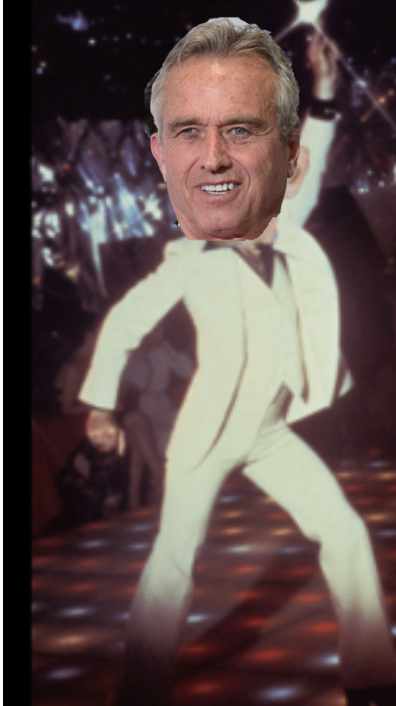
Image: Britanica.com
Next, we tested Thing #2, another culinary abomination: the Maraschino cherry. Although there is an ongoing debate about whether Maraschino cherries were ever living organisms, nonetheless, their age was measurable by the mass spec. The cherry was also 50 years old.
Finally, just to be thorough, we took a core sample for Fruitcake #17. This wasn't as easy as you might think.
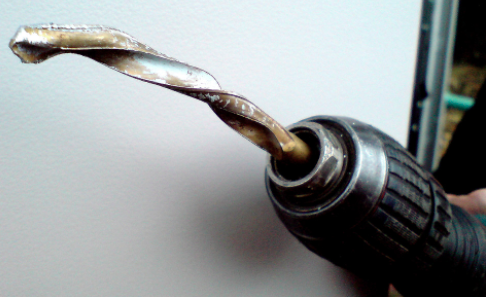
mage: Flickr
But with a bit of effort and a titanium drill bit, a sample was obtained.

I must say that I was a bit surprised by the result: only 98.1% of 14C remained. The handy dandy 14C dating calculator revealed that the base fruitcake was 163 years old, putting it right in the middle of the Civil War! Perhaps it was used in place of cannonballs.
The life of fruitcake #17
We can surmise the life of #17 by making certain assumptions. It was created at one time and later underwent post-market modifications. The core sample tells us that the atrocity was first baked in 1861, perhaps as a gift to President Lincoln, conceivably a first assassination attempt. A few years later, Andrew Johnson regifted it, perhaps to Robert E. Lee, to further rub it in that he lost the Civil War. Then things become murky. During Reconstruction, life was hard, and people were starving, especially in the South, but #17 was not eaten. It is possible that starving Southerners also regifted it during this time.
At some time between the late 1860s and 1971, the stuff on top was scraped off, possibly for use as rat poison, and the cake portion was used as insulation for an aircraft carrier or perhaps a punching bag. It is unclear whether a topless fruitcake gets regifted, but #17 reentered the regifting cycle when an unknown sadist added a new topping consisting of the unknown matter and Maraschino cherries. Now, 50 years later, it emerged as a lab specimen, which some unfortunate person will receive next year. Quite a journey indeed!
Others agree
I am hardly the only anti-fruiter out there. There are websites devoted to anti-fruitcakeism (See Burning Question: Why do so many people despise fruitcake?). I ran into some hilarious quotes. Here is my Christmas gift to all of you:
'The worst gift is a fruitcake. “There’s only one fruitcake in the world and people keep passing it around” (See that!)
Johnny Carson
“Airport screeners are now scanning holiday fruitcakes. Not even the scanners can tell what those little red things are.”
David Letterman
Have you ever known anyone who bought a fruitcake for himself? Of course not. They are purchased as Christmas gifts, mostly for people you don't particularly like.
Author: Phyllis Diller
I would eat fruitcake if there'd been a nuclear war and I'd run out of canned goods.
Author: Deb Caletti
The easiest way to make a fruitcake is to buy a darkish cake, then pound some old, hard fruit into it with a mallet. Be sure to wear safety glasses.
Author: Dave Barrett
Saving the best for last, here's some damn fine prose:
"For months they have lain in wait, dim shapes lurking in the forgotten corners of houses and factories all over the country and now they are upon us, sodden with alcohol, their massive bodies bulging with strange green protuberances, attacking us in our homes, at our friends’ homes, at our offices — there is no escape, it is the hour of the fruitcake."
Deborah Papier (a writer and editor)
(Actually, the worst/best quote by far was by Oscar Wilde, and it's in very poor taste. So much so that my colleagues yelled at me so I took the link out. Look it up if you wish but don't shoot the messenger.)
I think I'll stop here and wish all of you a happy, virus-free holiday season, from all the fruitcakes at ACSH.
